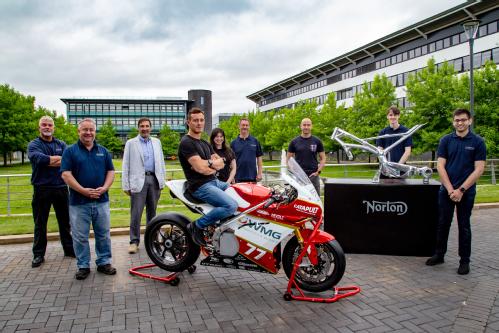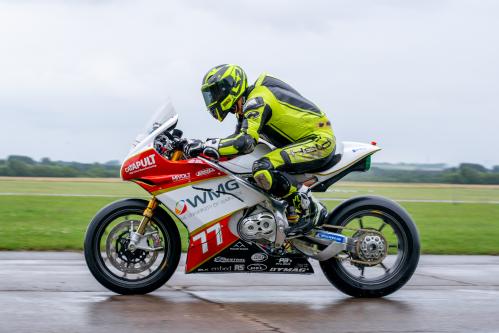Success Story Assetbank
Students race Embracing sustainability and electrification through motorcycle racing
The UK has formalised its ambitions to accelerate the shift to zero emission vehicles over the last year, which has been illustrated through policy commitments such as the government’s Ten Point Plan for a Green Industrial Revolution.
To reinforce this commitment, the transition to Electric Vehicles (EVs) of all types is being encouraged, with manufacturers doing all they can to make electrified mobility as convenient and cost effective as possible.
Aiming to embrace sustainability and electrification through motorcycle racing, a group of 15 undergraduate and EngD students from WMG, Engineering, Mathematics, Law, Computer Science and Physics departments across the University of Warwick set out ambitions to research the future of electric motorcycle racing in the summer of 2019. The goal was to overcome the challenge of designing, building and racing the University’s first fully electric race-spec superbike.
The Warwick Moto project was supported by WMG Centre High Value Manufacturing Catapult, alongside a selection of leading academics, engineers and researchers, all aiming to help create an electrically powered racing bike. The aim is to promote sustainability through electrification without compromising the characteristics seen in standard race-spec bikes. The project provided an opportunity for students from across the University to expand their knowledge and understanding of an industrial project.
Frontier: An innovative electric superbike solution
Impressed by the students’ ability to design a superbike demonstrated through the preceding ‘Aurora’ project, OEM manufacturer Norton Motorcycles decided to establish a collaboration with students from Warwick University, donating a high-performance sports bike frame and data to support the project and help nurture the skills of the students.
Culminating in the racing bike coined ‘Frontier’, the group produced a solution in just seven months, designing an electric powertrain to accompany the frame, which produces a power output of 160kW and 400Nm torque. This has been coupled with an immersion-cooled battery pack, which is a first of its kind for application in an electric motorcycle, with benefits including extended range and faster charging speed. A tailored control system has also been developed, demonstrating the in-house capability across the group.
The acceleration and speed characteristics of the electric bike in motion translate into a combustion-engine equivalent of around 900cc to 1,000cc.
In order to further the technology, the team also decided to utilise standard charging protocols on the vehicle, allowing not only fast charging capability but also the ability to charge at electric vehicle spots across the country. The vehicle uses the ChAdeMo protocol, and combined with immersion cooling, the team can charge to 80% in just 30 minutes.
These impressive figures have supported the testing and development of the electric bike prototype, with riding time on the track maximised thanks to reduced charging times.
Aman Surana, former Chief Engineer of the Warwick Moto team, said:
“The efforts of the whole Warwick Moto team during my time leading the project resulted in an innovative superbike in Frontier, which has now been widely showcased. Having now graduated, and since achieving a position at Norton Motorcycles, I can see how the learning and experience garnered throughout the project, both in terms of engineering and real-world management, were directly relevant and complementary to the requirements of modern industry. I look forward to seeing what the new cohort of students in the team have planned for the next instalment of the Warwick Moto project.”
Nesta Ferguson, new Chief Engineer of the Warwick Moto team added: “The collaboration between Norton and WMG at The University of Warwick to create the Frontier amounted to a fantastic example of sustainable EV innovation. The team hopes to set a precedent to its competitors and technological demonstrators and highlight how innovative projects like the Frontier are crucial if we are to help create a sustainable future. My role now is to build on the momentum established throughout the project. To do this, we have created a vision, which includes a four-year plan to ensure the longevity and continued development of the project.”
On-campus research has been reinforced with input, support, mentoring, and technical guidance from Norton’s own designers and engineers, further to the supply of the frame.
Making race debuts
Having undergone significant testing including much computer-based validation and modelling around thermal management, along with physical testing of cells and modules, Frontier has made several appearances outside of the workshop in recent weeks. This includes testing at Bicester Heritage where rider, Tom Weeden, summarised his first experiences:
“The first test aboard Frontier and working with the Warwick University team absolutely surpassed all my prior expectations. The professionalism of all the students was superb throughout and I had no issues trusting in the electric bike ‘Frontier’ that they had tirelessly created in such a short space of time.
“We eased into the test slowly, with an initial low power run at approx. 25% power output. Despite this, my initial feeling was hugely positive. The throttle connection and delivery of the power weren’t too dissimilar to a conventional internal combustion powered bike which was a pleasant surprise! As we upped the power the potential of the Norton framed Frontier bike was clearly evident! She handled beautifully from the off and with a little further testing time to dial in the suspension we can further enhance this. In fact, I found the bike really easy to ride - no gears, just twist and go and lots of fun! Despite the slight weight increase to a conventional bike the team have balanced it perfectly - plus there is plenty of potential for future suspension/geometry tweaks to further enhance the overall handling. All in all, a positive test showing plenty of potential for much more in the future! It’s an absolute pleasure and honour to be involved with the Frontier project!”
Having taken the bike to its first conference at the world’s number one festival of electric vehicles and clean energy, Fully Charged Live 2021, the team impressed the public once more by showcasing the bike alongside some of the largest EV manufacturers in the world at LCV Cenex 2021.
Dr Robert Hentschel, CEO of Norton Motorcycles, said:
“We are thrilled to be able to support the engineers of the future, who are developing tomorrow’s technology today on the basis of a Norton frame. Our support by means of donation of the frame is just the beginning. Norton’s team of designers and engineers have been very interested to observe how this project is taking shape, supporting the student team wherever possible with advice and guidance.”
Significant support from industrial partners such as the High Value Manufacturing (HVM) Catapult team at WMG, University of Warwick, Norton Motorcycles, Michelin Motorcycle PLC, MIVOLT by M&I Materials, PWR Advanced Cooling Technology, DYMAG Performance Wheels, Laserlines, Wraptastic, Rock West Composites, Xometry, Renthal, Pro-Bolt, embed, R&G Racing, R&G Gleam, HEL, and RS Components have immensely helped the team.


